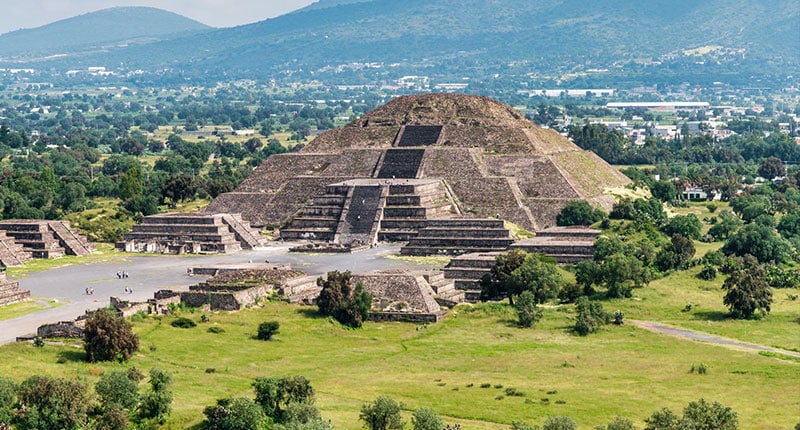
Teotihuacan, located in the Basin of Mexico, is an ancient Mesoamerican city that has captivated archaeologists and visitors alike. With its massive pyramids, intricate murals, and mysterious origins, Teotihuacan continues to intrigue researchers as they attempt to unravel its secrets. In this article, we will delve into the fascinating history, architecture, and cultural significance of Teotihuacan, shedding light on the enigmatic civilization that once thrived within its walls.
Unveiling the Mysteries of Teotihuacan
Teotihuacan, often referred to as the “City of the Gods,” flourished between the 1st and 7th centuries CE. It was one of the largest cities in the world at its peak, housing a population estimated to be around 100,000 inhabitants. However, the identity of its builders remains a mystery, as no written records have been found to provide definitive answers.
The Origins of Teotihuacan
The origins of Teotihuacan are shrouded in speculation. Archaeological evidence suggests that the city was established around 200 BCE, but it wasn’t until several centuries later that it experienced significant growth and expansion. The influence of other Mesoamerican cultures, such as the Olmec and Maya, can be seen in Teotihuacan’s art and architecture, indicating a complex network of trade and cultural exchange.
City Layout and Urban Planning
Teotihuacan was meticulously planned, with a grid-like layout comprising wide avenues, grand plazas, and residential compounds. The city was divided into distinct districts, each with its own purpose and unique architectural features. The Avenue of the Dead, the central thoroughfare of Teotihuacan, served as the backbone of the city, connecting various important structures.
The Magnificent Pyramids of Teotihuacan
The pyramids of Teotihuacan are among its most iconic structures. The Pyramid of the Sun, the largest pyramid in the city, rises majestically at the end of the Avenue of the Dead. Its impressive size and precise alignment with celestial bodies reflect the advanced astronomical knowledge possessed by the Teotihuacanos. The Pyramid of the Moon, another significant structure, was dedicated to the Great Goddess of Teotihuacan.
Murals and Artistic Expression
Teotihuacan is renowned for its vibrant and intricate murals, which provide valuable insights into the city’s culture and beliefs. These murals depict various themes, including deities, rituals, and daily life scenes. The use of vivid colors and meticulous details showcases the artistic prowess of the Teotihuacanos and their dedication to creating visually stunning works of art.
Everyday Life in Teotihuacan
Through archaeological discoveries, we have gained valuable knowledge about the daily lives of the Teotihuacan people. The city was a bustling center of trade, with evidence of long-distance commerce and a diverse range of goods. The residents engaged in various occupations, including agriculture, pottery production, and obsidian crafting. Social hierarchies and distinct living quarters further highlight the organized nature of Teotihuacan society.
Religion and Cosmology
Religion played a central role in Teotihuacan society. The city was dotted with temples, altars, and sacred spaces dedicated to various deities. The belief system of the Teotihuacanos revolved around a complex cosmology, which emphasized the cyclical nature of life and the interconnectedness of the universe. Ceremonial rituals, such as human and animal sacrifices, were performed to maintain cosmic balance.
The Decline and Abandonment of Teotihuacan
The reasons behind the decline and ultimate abandonment of Teotihuacan are still debated among scholars. Multiple factors, including social unrest, environmental changes, and external invasions, are believed to have contributed to its downfall. By the 8th century CE, Teotihuacan was largely abandoned, leaving behind a once-thriving city that eventually faded into obscurity.
Rediscovery and Excavation
Teotihuacan remained hidden beneath layers of time until its rediscovery in the 19th century. Since then, extensive archaeological excavations have been conducted, unearthing remarkable artifacts, structures, and insights into the lives of the Teotihuacanos. Ongoing research and exploration continue to shed light on the mysteries that still surround this ancient city.
The Legacy of Teotihuacan
The influence of Teotihuacan extended far beyond its physical boundaries. Its architectural styles, artistic motifs, and religious practices left an indelible mark on subsequent Mesoamerican civilizations. The city’s legacy can be seen in the art and architecture of later cultures, including the Aztecs. Teotihuacan remains a symbol of ancient ingenuity and a testament to the rich cultural tapestry of Mesoamerica.
Conclusion
Teotihuacan stands as a testament to the power and ingenuity of the ancient Mesoamerican civilizations. Its awe-inspiring pyramids, intricate murals, and advanced urban planning continue to captivate our imagination. Although many secrets of Teotihuacan remain concealed, ongoing research and exploration bring us closer to unraveling the enigmatic story of this remarkable city.
FAQs
1. How old is Teotihuacan?
- Teotihuacan dates back to around 200 BCE, with its peak occurring between the 1st and 7th centuries CE.
2. Who built Teotihuacan?
- The builders of Teotihuacan remain unknown. No written records have been found to definitively identify its creators.
3. Can you climb the pyramids at Teotihuacan?
- Currently, climbing the pyramids at Teotihuacan is prohibited for visitor safety and to preserve the structures.
4. What does Teotihuacan mean?
- Teotihuacan translates to “the place where the gods were created” in the Nahuatl language.
5. Are there guided tours available at Teotihuacan?
- Yes, guided tours are available at Teotihuacan, providing visitors with informative insights into the history and significance of the ancient city.
